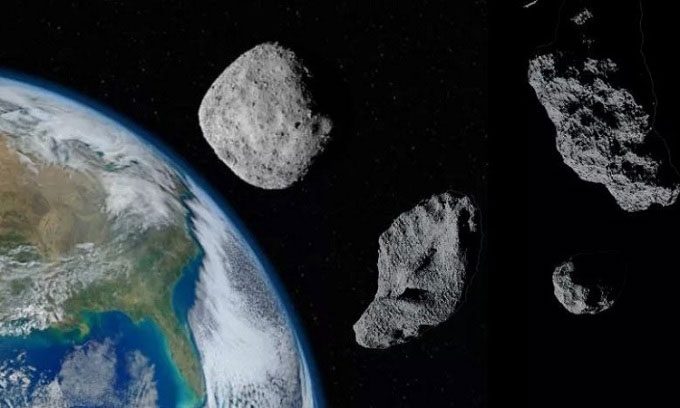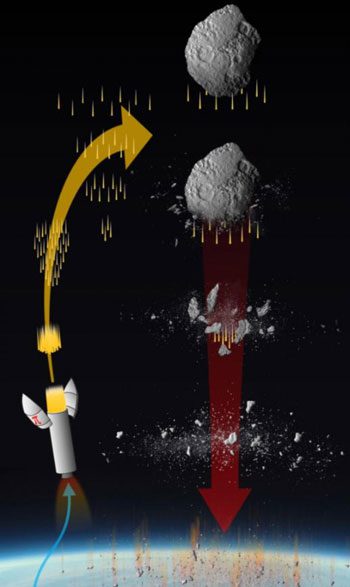American Scientist Proposes Idea to Launch a Ship to Collide with an Asteroid and Destroy It to Prevent Danger
Professor Philip Lubin at the University of California, Santa Barbara, has developed a concept for protecting Earth called PI-Terminal Defense for Humanity. PI stands for Pulverize It, meaning to crush into pieces. Lubin argues that pulverizing an asteroid heading toward Earth is an effective solution for protecting humanity when there is only a short time to act. He presented his idea at the Planetary Defense Conference in 2021 and received funding through the NASA Innovative Advanced Concepts (NIAC) program.

Simulation of asteroids approaching Earth. (Photo: Dzika Mrowka)
Many solutions for protecting Earth from asteroid impacts require a long implementation time. If a collision threat is detected months or years in advance, experts can launch a spacecraft to deflect the asteroid. With sufficient preparation time, even a small impact can redirect a large asteroid.
Lubin’s solution targets unexpected scenarios when scientists discover a collision risk too late. Essentially, he aims to break the celestial body into small fragments so that they burn up in Earth’s atmosphere.
Specifically, Lubin wants to create a spacecraft that not only impacts the asteroid with kinetic energy but can also explode. The ship would be equipped with penetrating rods to strike the asteroid, some of which would be filled with explosives. The explosion would shatter the asteroid into many smaller pieces, ideally with diameters of 15 meters or less.
The fragments would form a cloud of debris. Depending on the size of the asteroid, the size of the spacecraft, and the distance from Earth at the time of detonation, some debris may crash into Earth. However, most would be destroyed upon friction with the atmosphere.

Plan to destroy the asteroid using the PI system. (Photo: Lubin/Experimental Cosmology Group, UCSB)
“The effectiveness of the new method depends on the timing of the interception and the size of the asteroid. However, it still provides effective protection for Earth against asteroids with diameters of hundreds of meters and can almost eliminate the risk of mass extinction they pose,” Lubin explained.
According to Lubin, the PI system could be placed in Earth’s orbit or even on the Moon. “Compared to other risk mitigation methods, this approach represents a cost-effective, verifiable, and deployable solution with a reasonable development and testing roadmap. Pre-installing the system in Earth’s orbit or on the Moon allows for rapid response in less than a day if needed,” Lubin stated.
The Moon has several advantages. For instance, this celestial body has no atmosphere, so if used as a base to observe near-Earth asteroids, experts could detect them from afar using advanced tools. The Moon also has a lower escape velocity than Earth, making launches easier and less costly.
Launching a large spacecraft carrying explosives from Earth is also becoming more feasible. Heavy-lift vehicles like SpaceX’s Falcon Heavy, NASA’s Space Launch System (SLS), and other vehicles are ushering in a new era of powerful rocket technology.
Lubin noted that the PI system only needs 5 hours before an impact to destroy an asteroid the size of the object in the Tunguska event. This object is believed to have a diameter of about 50 meters and exploded with a force equivalent to 10 million tons of TNT, flattening millions of trees in a remote area of Siberia.
If an object of similar size were to explode over a city, the consequences would be catastrophic. The Chelyabinsk meteorite streaked across the sky in Russia in 2013, shattering countless windows and injuring about 1,500 people, despite being only 20 meters in diameter.
The PI system is also effective against larger asteroids like Apophis, which has a diameter of up to 370 meters. According to Lubin, the PI system could successfully destroy celestial bodies the size of Apophis if intercepted 10 days before it strikes Earth.





















































